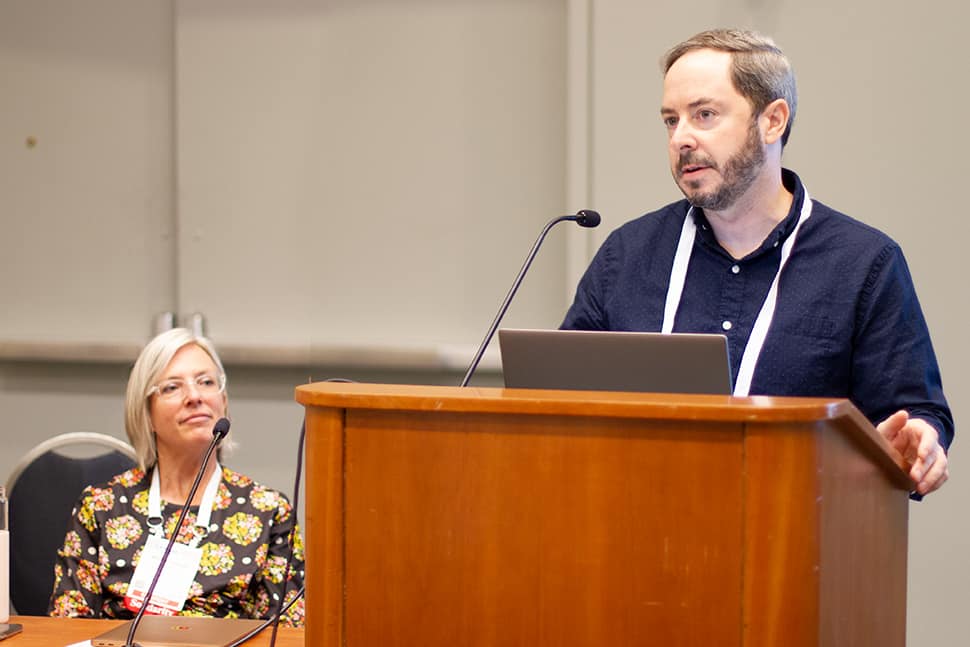
Everybody is digitizing, says Brooke Becker, chair-elect of the Reference and User Services Association’s History Section. “What you don’t necessarily always see is ‘should we,’ and ‘where should this be accessible?”
In the session “From Censorship to Digitization: Bringing Sensitive Collections to Light” at the American Library Association’s 2022 Annual Conference and Exhibition on June 25, presenters explored historical contexts and forward-looking digital projects and how they affect marginalized communities.
“What’s happening in people’s lives is happening in our collections,” said Melissa Alder, assistant professor of information and media studies at Western University in London, Ontario. Standing in front of a photo of June 24 protests at the Supreme Court against its ruling to end the right to abortion, Adler drew a connection between reactionary waves of censorship in US history and how information is classified, preserved, and accessed. She encouraged people to think deeply about the relationship between libraries, state power, heteropatriarchy, and “how our collections participate in these discourses and empire-building.”
Infrastructures can facilitate or bar access to collections, Adler said. In her research on the Library of Congress’s Delta Collection, which assembled books that were sensitive—largely regarding sex and sexuality—but important to the cultural record, she argues that “the point was to protect the public from the materials, but also to protect the materials themselves.” The collection gained political and historical significance during the McCarthy Era, when there was a significant crackdown on these types of materials. Adler noted that there are many parallels to the wave of book bans and censorship today.
Bias and censorship can also enter classification systems in more subtle ways. When Thomas Jefferson sold his personal library to Congress to replace books the Library of Congress lost to fire during the War of 1812, his classification system for those books went with them. Jefferson, a man who enslaved more than 600 people in his lifetime, Adler noted, had consigned the letters of Ignatius Sancho, a Black abolitionist, to the “bottom of the column” in his system, saying that his writing was too emotional and unreasonable. Such anecdotes, Adler hopes, drive home the connection between classification and colonial history. Adler encouraged attendees to think about the ways that humanities and literacy itself rely on and produce dehumanizing processes, contexts, and situations.
Timothy Vollmer, scholarly communication and copyright librarian at University of California, Berkeley, spoke during the second half of the session about the university’s digital life-cycle program and the processes the libraries are creating to make collections accessible while still protecting the rights and needs of marginalized people.
They consider four main factors in whether to make materials available online: copyright, privacy, contracts, and ethics. While the first three are based on law, the third is a more complex and nuanced issue where there is not yet consensus. The library created two sets of policy guidelines, one for general collection materials, and another specifically addressing the care and dissemination of Indigenous materials.
Vollmer noted that traditional ethical frameworks assume an equal power structure. The university libraries decided to build its processes around an ethics of care, considering power imbalances; whether the subjects or creators of a collection would have accounted for mass online distribution of the content; and the rights and obligations of groups (instead of just individuals).
The framework attempts to balance judgments of value and harm in making collection items available. Harm is given more weight where an item has negative impacts to disadvantaged communities, is about a community (instead of created by that community), or the creator had less ability to control the information being shared. When it comes to Indigenous materials, the framework further considers whether a collection item is, may be, or is not culturally sensitive—defined to be material that depicts a tribal spiritual or religious place, object, belief, or activity. In situations where the material is potentially culturally sensitive, outreach is made to the community. This framework also makes space for partnerships with tribes and other Indigenous groups to provide input on metadata and set terms and conditions for access.
“What we choose to do with our collections […] will affect other people, and the library should care about that,” Vollmer said.


